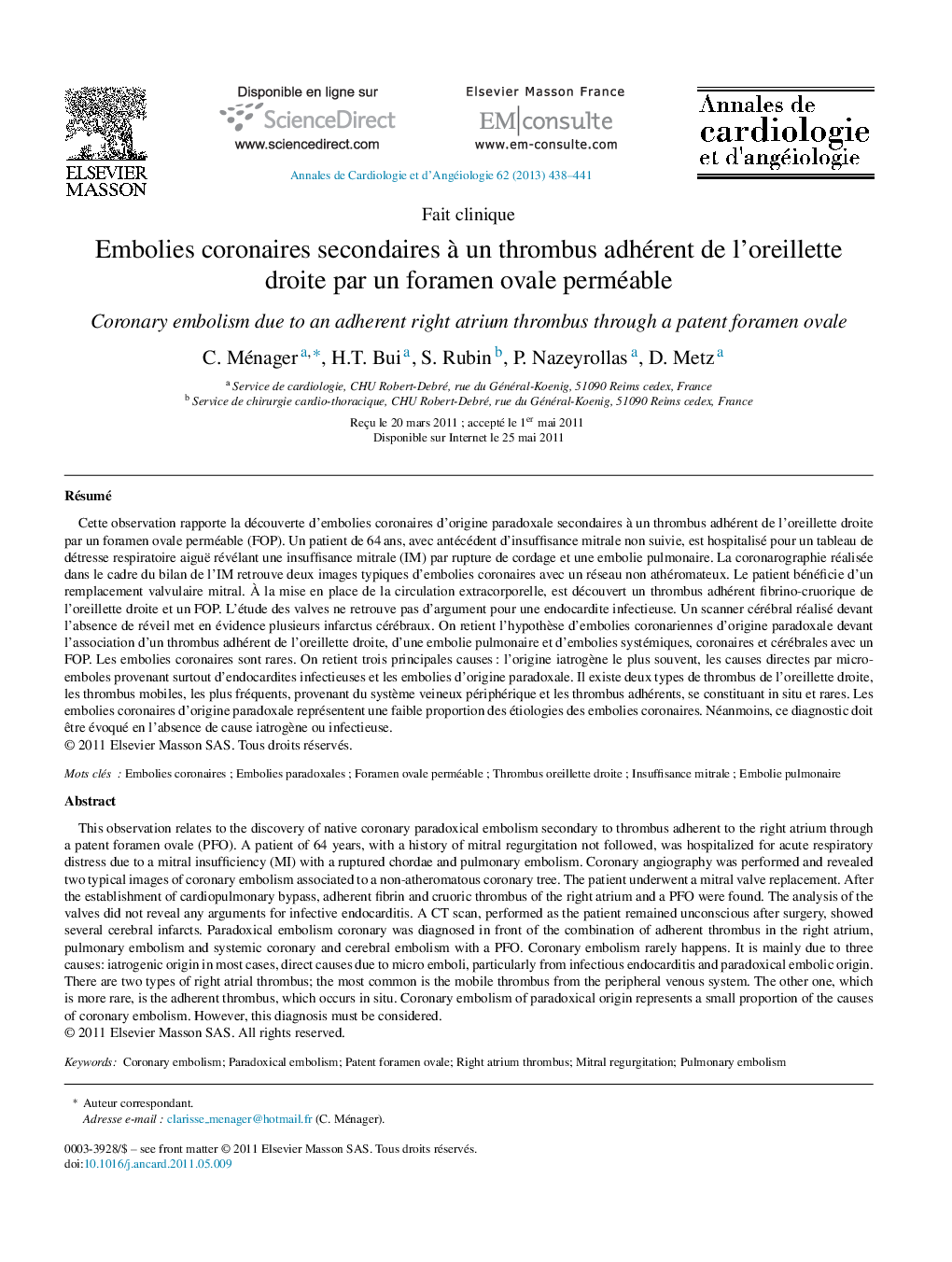| Article ID | Journal | Published Year | Pages | File Type |
|---|---|---|---|---|
| 2868983 | Annales de Cardiologie et d'Angéiologie | 2013 | 4 Pages |
RésuméCette observation rapporte la découverte d’embolies coronaires d’origine paradoxale secondaires à un thrombus adhérent de l’oreillette droite par un foramen ovale perméable (FOP). Un patient de 64 ans, avec antécédent d’insuffisance mitrale non suivie, est hospitalisé pour un tableau de détresse respiratoire aiguë révélant une insuffisance mitrale (IM) par rupture de cordage et une embolie pulmonaire. La coronarographie réalisée dans le cadre du bilan de l’IM retrouve deux images typiques d’embolies coronaires avec un réseau non athéromateux. Le patient bénéficie d’un remplacement valvulaire mitral. À la mise en place de la circulation extracorporelle, est découvert un thrombus adhérent fibrino-cruorique de l’oreillette droite et un FOP. L’étude des valves ne retrouve pas d’argument pour une endocardite infectieuse. Un scanner cérébral réalisé devant l’absence de réveil met en évidence plusieurs infarctus cérébraux. On retient l’hypothèse d’embolies coronariennes d’origine paradoxale devant l’association d’un thrombus adhérent de l’oreillette droite, d’une embolie pulmonaire et d’embolies systémiques, coronaires et cérébrales avec un FOP. Les embolies coronaires sont rares. On retient trois principales causes : l’origine iatrogène le plus souvent, les causes directes par micro-emboles provenant surtout d’endocardites infectieuses et les embolies d’origine paradoxale. Il existe deux types de thrombus de l’oreillette droite, les thrombus mobiles, les plus fréquents, provenant du système veineux périphérique et les thrombus adhérents, se constituant in situ et rares. Les embolies coronaires d’origine paradoxale représentent une faible proportion des étiologies des embolies coronaires. Néanmoins, ce diagnostic doit être évoqué en l’absence de cause iatrogène ou infectieuse.
This observation relates to the discovery of native coronary paradoxical embolism secondary to thrombus adherent to the right atrium through a patent foramen ovale (PFO). A patient of 64 years, with a history of mitral regurgitation not followed, was hospitalized for acute respiratory distress due to a mitral insufficiency (MI) with a ruptured chordae and pulmonary embolism. Coronary angiography was performed and revealed two typical images of coronary embolism associated to a non-atheromatous coronary tree. The patient underwent a mitral valve replacement. After the establishment of cardiopulmonary bypass, adherent fibrin and cruoric thrombus of the right atrium and a PFO were found. The analysis of the valves did not reveal any arguments for infective endocarditis. A CT scan, performed as the patient remained unconscious after surgery, showed several cerebral infarcts. Paradoxical embolism coronary was diagnosed in front of the combination of adherent thrombus in the right atrium, pulmonary embolism and systemic coronary and cerebral embolism with a PFO. Coronary embolism rarely happens. It is mainly due to three causes: iatrogenic origin in most cases, direct causes due to micro emboli, particularly from infectious endocarditis and paradoxical embolic origin. There are two types of right atrial thrombus; the most common is the mobile thrombus from the peripheral venous system. The other one, which is more rare, is the adherent thrombus, which occurs in situ. Coronary embolism of paradoxical origin represents a small proportion of the causes of coronary embolism. However, this diagnosis must be considered.
